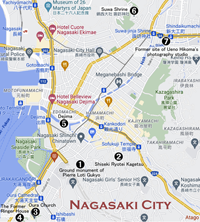 |
||
 In Nagasaki, you can still find Loti's footprints. In Juzenji Temple (today 9-23 Junin- machi, Nagasaki), there is a monument to commemorate the place where Loti and Okane-san lived. The stairs and rock walls still remain but the building does not exist anymore. Instead, there is a drawing of the house they lived. After arriving at Nagasaki,
we learned that Okane-san's living range was very narrowt. The house of her parents- in-law, Sato family, where she lived and Maruyama and the port are about 200 meters away. From the house to Dejima, Ohura Cathedral, and Golver's House was about 500 meters in distance. Loti asked Kangoro to arrange a lady. Loti did not like the lady Kangoro brought, but he liked Okane-san, who was an escort for the lady.
Loti asked "what about that lady?" Kangoro was surprised and said "She is a geisha. No way!" This conversation tells us that there was a strict distinction between a geisha and prostitute. Kangoro persuaded Sato and Oume, Oaken-san's parents-in-law, to sell her for 20 Piastre per month.
Loti's monument stands in the Nagasaki Park next to Suwa Shrine (a famous shrine for Nagasaki Kunchi festival). The monument was a gift from the French government and established in the park in 1950. Tsukimi Chaya in the Nagasaki Park opened in 1885, the same year Loti visited Japan. Loti actually introduced it as Donko Chaya. If you visit Suwa Shrine, climb up the stairs to arrive at the worship hall; on the left is Tsukimi Chaya in the park; in front of the park is Loti's monument. Then, in front of the Suwa Shrine was Hikoma Ueno's photo studio, where the cover photo of this brochure was taken.
In Nagasaki, you can still find Loti's footprints. In Juzenji Temple (today 9-23 Junin- machi, Nagasaki), there is a monument to commemorate the place where Loti and Okane-san lived. The stairs and rock walls still remain but the building does not exist anymore. Instead, there is a drawing of the house they lived. After arriving at Nagasaki,
we learned that Okane-san's living range was very narrowt. The house of her parents- in-law, Sato family, where she lived and Maruyama and the port are about 200 meters away. From the house to Dejima, Ohura Cathedral, and Golver's House was about 500 meters in distance. Loti asked Kangoro to arrange a lady. Loti did not like the lady Kangoro brought, but he liked Okane-san, who was an escort for the lady.
Loti asked "what about that lady?" Kangoro was surprised and said "She is a geisha. No way!" This conversation tells us that there was a strict distinction between a geisha and prostitute. Kangoro persuaded Sato and Oume, Oaken-san's parents-in-law, to sell her for 20 Piastre per month.
Loti's monument stands in the Nagasaki Park next to Suwa Shrine (a famous shrine for Nagasaki Kunchi festival). The monument was a gift from the French government and established in the park in 1950. Tsukimi Chaya in the Nagasaki Park opened in 1885, the same year Loti visited Japan. Loti actually introduced it as Donko Chaya. If you visit Suwa Shrine, climb up the stairs to arrive at the worship hall; on the left is Tsukimi Chaya in the park; in front of the park is Loti's monument. Then, in front of the Suwa Shrine was Hikoma Ueno's photo studio, where the cover photo of this brochure was taken.
 |
||